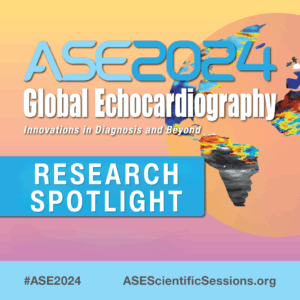
FOR IMMEDIATE RELEASE
Contact: Angie Porter
919-297-7152
[email protected]
Two Research Studies at ASE 2024 Examine Environmental Factors and Heart Health
 (DURHAM, NC, June 14, 2024)—A number of factors can determine a person’s heart health—genetics, physical activity, diet, and even the environment. Two international research studies that will be presented during the American Society of Echocardiography’s (ASE) 35th Annual Scientific Sessions, June 14-16, 2024, in Portland, Oregon, examined the effects the latter on the heart.
(DURHAM, NC, June 14, 2024)—A number of factors can determine a person’s heart health—genetics, physical activity, diet, and even the environment. Two international research studies that will be presented during the American Society of Echocardiography’s (ASE) 35th Annual Scientific Sessions, June 14-16, 2024, in Portland, Oregon, examined the effects the latter on the heart.
The first study, titled “Maternal Exposure to Ambient Ozone and Fetal Conotruncal Congenital Heart Defects in China: A Large Multicenter Cohort Study,” delves into the effects of ozone (O3) pollution on fetal heart development. From January 2013 to December 2021, the study examined more than 24,000 pregnant women at Beijing Anzhen Hospital, Capital Medical University in China to investigate the association between maternal exposure to O3 and conotruncal heart defects (CTDs), which are congenital heart malformations that affect the heart’s outflow tracts and great arteries.
Fetal echocardiography was used to evaluate fetuses with CTDs, and the research findings revealed that maternal exposure to ambient O3 pollution during critical periods, especially during the periconception period, may increase the risk of CTDs in fetuses.
“To prevent this impact, pregnant women should adopt healthy lifestyles and avoid exposure to O3 pollution during peak hours, which can occur in traffic congested or industrial areas,” says the study’s lead author, Yihua He, an expert in fetal congenital heart disease and the Director of the Echocardiography Medical Center and Maternal-fetal Medicine Center in Fetal Heart Disease at Beijing Anzhen Hospital, Capital Medical University. “Additionally, governments and the public should implement measures to decrease O3 pollution, such as reducing emissions from industrial and transportation sources, promoting clean energy, and implementing air quality standards.”
Dr. He emphasized the need for further research to understand the impact of other environmental factors on fetal heart development and to develop appropriate preventive measures.
The second study, titled “Echocardiographic Assessment of Pulmonary and Right Chamber Parameters in Healthy Individuals Who Live More Than 8200 Feet Above the Sea Level: A Colombian Experience,” focused on long-term cardiopulmonary adjustments in individuals residing at high altitudes, specifically those living more than 8,200 feet above sea level (FASL).
The study, conducted in the Andean Mountains in Colombia, where over 35 million people live at such altitudes, examined the prevalence of high-altitude pulmonary hypertension and its implications on the right ventricle and clinical outcomes. Contrary to what was expected, the findings indicated that individuals living above 8200 FASL do not exhibit higher estimated systolic pulmonary artery pressure (sPAP) or significant differences in right ventricle dimensions and function.
However, findings did discover a significant difference between the study’s two Colombian cohorts from Bogota (8,612 FASL) and Aquitania (9,941 FASL). There was a surprisingly higher prevalence of Stage 2 hypertension and an increase in relative wall myocardium thickness in the Aquitania cohort. It was determined there is a need for further investigation into the long-term adaptive mechanisms in adults residing at high altitudes, as it may lead to adverse cardiovascular outcomes.
“The effects of pulmonary and arterial hypertension include capillary remodeling and permeability changes that result in pressure load on the right or left ventricle respectively. If uncontrolled, changes can lead to ventricular failure with a reduced exercise capacity and premature death. Therefore, if undiagnosed, high-altitude dwellers could be at risk of developing clinically relevant events,” says the study’s lead author Astrid Lorena Rodriguez, an internal medicine resident at Fundacion Santa Fe, Bogota in Colombia. “We expect our results to encourage global leaders and colleagues to further research long-term cardiopulmonary adjustments to better understand clinical outcomes in this population.”
Both research studies will be presented at the Oregon Convention Center during ASE 2024, which features more than 450 abstract presentations showcasing cutting-edge research on the latest advances in cardiovascular ultrasound and cases illustrating breakthroughs in patient care. Learn more about ASE 2024 and download the conference’s final event program at ASEScientificSessions.org.
About American Society of Echocardiography
The American Society of Echocardiography (ASE) is the Society for Cardiovascular Ultrasound Professionals™. ASE is the largest global organization for cardiovascular ultrasound imaging serving physicians, sonographers, nurses, veterinarians, and scientists and as such is the leader and advocate, setting practice standards and guidelines for the field. The Society is committed to advancing cardiovascular ultrasound to improve lives. For more information visit ASE’s website ASEcho.org or social media pages on Facebook, X (formerly Twitter), LinkedIn, or Instagram.
###
Publish date
June 14, 2024
Topic
- Events
- Research
Related News

Announcements

Press Release

Announcements
